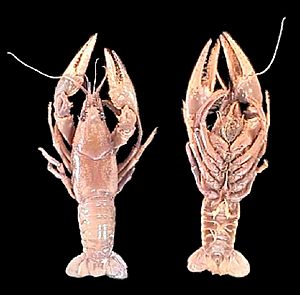Orconectes facts for kids
Quick facts for kids Orconectes |
|
|---|---|
 |
|
| Scientific classification |
|
| Kingdom: | Animalia |
| Phylum: | Arthropoda |
| Subphylum: | Crustacea |
| Class: | Malacostraca |
| Order: | Decapoda |
| Family: | Cambaridae |
| Subfamily: | Cambarinae |
| Genus: | Orconectes Cope, 1872 |
| Type species | |
| Orconectes inermis Cope, 1872
|
|
| Subgenera | |
|
|
Orconectes is a special group of crayfish that mostly live in dark caves! These amazing freshwater creatures are found in the eastern United States and Canada. Imagine a tiny lobster that spends its whole life underground – that's a bit like an Orconectes crayfish.
Before 2017, some crayfish that lived on the surface (not in caves) were also part of the Orconectes group. But now, those surface-dwelling species have their own group called Faxonius. This helps scientists understand them better!
Contents
What are Orconectes Crayfish?
Crayfish are small, freshwater animals that look a lot like tiny lobsters. They have a hard outer shell, ten legs, and two large claws called pincers. They use their pincers for catching food and defending themselves. Orconectes crayfish are unique because many of them have adapted to life in caves.
Life in the Dark: Cave Crayfish
Living in a cave is very different from living in a river or lake. Caves are usually dark, quiet, and have a steady temperature. Cave-dwelling Orconectes crayfish often have special features that help them survive in this environment. For example, some cave crayfish have very small or even no eyes, because they don't need to see in the dark. Instead, they rely on their other senses, like touch and smell, to find their way around and search for food.
They also tend to be paler in color, sometimes even white or translucent, because they don't need camouflage from predators in the dark. Their diet in caves usually consists of tiny bits of organic matter that wash into the cave from the surface.
How Many Orconectes Species Are There?
The Orconectes group was first named in 1872 by a scientist named Edward Drinker Cope. He described two species, Astacus pellucidus (which is now called Orconectes pellucidus) and a new species he found, Orconectes inermis.
Today, scientists know about approximately 85 different kinds of Orconectes crayfish! These many species are divided into 11 smaller groups, which scientists call "subgenera." Each subgenus contains species that are closely related to each other. For example, some of the subgenera are Billecambarus, Crockerinus, and Orconectes (which is also a subgenus within the main genus!).
Each species has a unique scientific name, like Orconectes australis (the southern cave crayfish) or Orconectes sheltae (the Shelta cave crayfish). These names help scientists around the world know exactly which animal they are talking about.
Where Do Orconectes Crayfish Live?
These crayfish are native to the eastern parts of the United States and Canada. This means they naturally live in these areas and nowhere else in the world. You can find different species in various states, from Alabama and Tennessee to Kentucky, Missouri, and even Ontario in Canada.
Many of them live in underground water systems, like those found in Kentucky's famous Mammoth Cave. Their homes are often hidden away from the surface, making them fascinating creatures for scientists to study.

